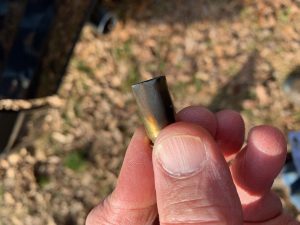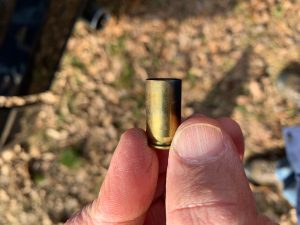Use of .45 ACP Ammunition in Operation Enduring Freedom (2001–2014)
Operation Enduring Freedom (OEF, 2001–2014) saw U.S. forces in Afghanistan primarily armed with rifles and 9×19 mm sidearms. The .45 ACP (Automatic Colt Pistol) cartridge was not a standard-issue caliber for most troops during this period. Instead, .45 ACP ammunition was used in limited quantities by specialized units, such as certain U.S. special operations forces and elite Marine Corps units
. As a result, the number of .45 ACP rounds supplied or expended in Afghanistan was only a small fraction of overall ammunition usage in OEF.
Special Operations Forces and .45 ACP Use
A Colt M45A1 .45 ACP pistol as used by USMC special operations units in Afghanistan (tan Cerakote finish worn from field use)
. U.S. special operations forces and the USMC’s elite units continued to favor .45 caliber pistols for their greater stopping power, even after the rest of the military switched to 9 mm in the 1980s
. During OEF, .45 ACP was carried by units such as:
-
Army Special Forces and Delta Force – These units historically used customized M1911A1 pistols and other .45 caliber handguns. Delta Force, for example, was a proponent of the .45 ACP round, valuing its performance in close-quarters scenarios
. Many Delta operators in the 2000s deployed with match-grade M1911-type pistols before later transitioning to other platforms (e.g. Glock)
.
-
Marine Corps Force Recon and MARSOC – The USMC issued .45 caliber pistols (designated M45 or M45A1 Close-Quarters Battle Pistols) to Force Reconnaissance and Marine Raider units
. Early in OEF, these were hand-built M45 MEU(SOC) .45 pistols; by 2012 a new Colt M45A1 was adopted under a $22.5 million contract for up to 10,000 pistols
. Each Marine special operator carried this .45 sidearm in Afghanistan, reflecting the continued preference for .45 ACP among elite Marines.
-
Navy Special Warfare – Some Navy SEALs also used .45 caliber sidearms. Notably, the SEALs had adopted the Mk23 Mod 0 SOCOM pistol (a large H&K .45 ACP handgun) in the 1990s, and later variants like the HK45C. While many SEALs in OEF carried 9 mm Sig P226s or, later, Glock 19s, certain missions (requiring suppressed fire or extra stopping power) still saw .45 ACP pistols in use
.
Outside of special operations, most U.S. personnel in Afghanistan did not use .45 ACP. The standard sidearm for Army and conventional Marine units was the 9 mm M9 pistol, and even crew-served or vehicle weapons did not use .45 (they used 5.56 mm, 7.62 mm, .50 BMG, etc.). An Army House Armed Services Committee hearing in 2004 highlighted that 5.56 mm, 7.62 mm, and .50 BMG rounds made up over 95% of small-arms expenditures, leaving all other calibers (including 9 mm and .45) to share less than 5%
. This underscores that .45 ACP was a niche ammunition type in the Afghan theater compared to the billions of rifle and machine gun rounds expended.
Procurement and Supply Data for .45 ACP (2001–2014)
Because .45 ACP was used by a limited subset of forces, it was procured in modest quantities relative to other ammunition. The Department of Defense did not publicly break out exact .45 ACP consumption for Afghanistan, but available procurement records and reports give some insight:
-
Annual DoD Ammo Procurement: The U.S. military’s overall demand for small-caliber ammunition (all types under .50) skyrocketed during the war on terror, rising from ~730 million rounds in FY2000 to nearly 1.8 billion rounds by FY2005
. Within this huge increase, most were 5.56 mm and 7.62 mm rounds for rifles and machine guns. By contrast, .45 ACP constituted a very small portion. For example, if ~1.8 billion small-caliber rounds were needed in 2005, under 5% of that (~90 million) covers all other calibers beyond the main three
– and .45 ACP would be only a fraction of that figure (since 9 mm pistol ammo needs for regular forces were larger than .45 needs). Thus, the scale of .45 usage was in the low millions of rounds, not hundreds of millions, over the entire conflict.
-
U.S. Army and Joint Ammunition Purchases: The Army’s Program Executive Office for Ammunition handled most ammo procurement for all services during OEF
. The Army’s budget documents generally lump .45 ACP under generic “small arms ammo” lines, but special orders were placed to support units needing .45. Notably, ammunition contracts via Army Contracting Command included .45 ACP as a line item alongside 9 mm. (For instance, a 2016 Army contract to Olin-Winchester covered 9 mm, .38, and .45 caliber pistol ammunition in one package
, reflecting how these pistol calibers are grouped for procurement). During OEF, DoD often sourced .45 ACP from commercial manufacturers (such as Federal Cartridge/ATK or Olin Winchester) since the primary government-owned ammo plant focused on NATO calibers
.
-
Marine Corps Ammo Reports: A 2008 DoD Inspector General audit of ammunition funds provides a snapshot of .45 ACP supply. In one USMC supplemental ammunition request for GWOT (FY2007), the Marine Corps ordered approximately 274,000 rounds of .45 caliber ammunition as part of its OEF/OIF needs
. This single order (costing ~$98.6 K) was relatively small – by comparison, the same document shows orders of millions of rounds of 5.56 mm in that year【44†】. The Marine Corps confirmed that the M45 .45 caliber pistol was standard for Recon and MARSOC personnel in OEF
, and they allocated war funding to buy both the new pistols and the ammo to feed them. As MARSOC expanded after 2006, annual .45 ACP procurement for the Marines likely stayed in the few-hundred-thousand range to supply training and deployments.
-
SOCOM and Other Services: U.S. Special Operations Command units (Army SF, Navy SOF, etc.) draw ammo from service channels, so their .45 ACP needs were fulfilled through Army and Navy ordnance logistics. While detailed breakdowns are not public, it’s known that SOCOM kept .45 ACP in inventory for units fielding weapons like the MK23 pistol or HK UMP45 submachine gun. These specialty ammo requirements were relatively small and often satisfied by contracts with major ammo suppliers. For example, Winchester Ammunition has been a key supplier for military pistol ammo; it received multi-year contracts to produce .45 ACP for the Army both during and after OEF
. This ensured that deployed special operators in Afghanistan had a steady supply of .45 ACP for their sidearms, even though the caliber’s usage was limited.
Estimates of .45 ACP Rounds Used in Afghanistan (2001–2014)
No precise public figure exists for the total .45 ACP rounds expended in OEF, but given the above information we can outline the best estimates and context:
-
Magnitude: Over 13 years of war, U.S. forces in Afghanistan probably used on the order of a few million rounds of .45 ACP in total. This is tiny compared to rifle ammunition – for perspective, U.S. forces expended billions of 5.56 mm rounds in Iraq/Afghanistan. Even 9 mm pistol ammo (standard for most troops) vastly outweighed .45 usage. One military estimate noted that pistol and other small calibers (aside from 5.56/7.62/.50) accounted for under 5% of rounds fired
, and .45 was only a subset of that category. Thus, if 5.56 and other main rounds numbered in the billions, .45 ACP likely numbered in the low single-digit millions at most across the entire conflict.
-
Annual Usage Patterns: In the early years of OEF (2001–2005), .45 ACP use was minimal – only certain special ops (like Army Delta or some SEALs) were deployed with .45 pistols, since the Marine Force Recon teams (users of .45 MEU(SOC) pistols) were relatively few. After 2006, the formation of MARSOC and continued deployments of Army Special Forces increased the number of .45-caliber weapons in theater. By the peak war years (2009–2012), the Marine MARSOC and Recon teams, Army SF ODAs, and a portion of Navy SOF were each deploying with .45 sidearms. If we assume a few hundred operators carrying .45 pistols at any given time, each might fire a few hundred rounds in theater per year for proficiency or combat – that yields maybe tens of thousands of rounds per year in-country. Much larger quantities would be used in pre-deployment workups and training back in the US (which wouldn’t count as OEF consumption but drove procurement). For example, an entire MARSOC company workup can consume tens of thousands of .45 rounds in training, ensuring operators are proficient with their pistols.
-
Supply vs. Combat Expenditure: It’s important to distinguish ammunition supplied to Afghanistan from rounds actually fired in combat. Ammunition supply often exceeds expenditure to ensure ample reserve. The U.S. likely shipped hundreds of thousands of .45 ACP rounds to Afghanistan over the course of OEF to equip special ops units and security details. Not all of this would be shot; some would be used for range practice on bases, some carried on missions, and any surplus eventually redeployed or disposed of. Toward the war’s end, efforts like “Operation Ammunition Clean Sweep” collected unused munitions for retrograde
– it’s plausible that leftover .45 ammo was among recovered stocks, given its limited use. In short, the rounds fired in combat were likely a subset of those delivered. (For context, direct firefights involving pistols were rare; most troops, even special ops, relied on primary weapons first. The .45’s role was often as a secondary weapon or for close-quarter scenarios.)
In summary, while exact figures are unavailable, .45 ACP ammunition played a very limited role in OEF. It was primarily used by special operations and elite Marine units, with yearly procurement in the low hundreds of thousands of rounds and aggregate usage on the order of only a few million rounds over 13 years. This is negligible next to the standard rifle and machine-gun ammo expenditures
. Nonetheless, the military ensured that those who needed .45 ACP – from Delta Force operators to Marine Raiders – were reliably supplied throughout the conflict, via dedicated contracts and logistics channels
. The continued procurement of .45 ACP (even beyond OEF’s end) underscores that this cartridge remained an important niche capability for U.S. forces, valued for its proven effectiveness in the close-quarters and special mission contexts encountered in Afghanistan.
Sources: Military ammunition supply audits and budgets
; U.S. Congressional testimony on small-caliber ammo in GWOT
; Department of Defense contract records
; defense industry reporting on special operations weapons
; and official USMC statements on .45 pistol fielding





